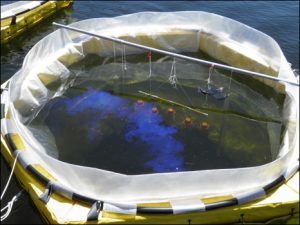In this post, Mirco Bundschuh talks about their recently published paper “Monitoring the Fate and Transformation of Silver Nanoparticles in Natural Waters”.

Dosing of silver nanoparticles to a lake mesocosm (photo by C. Metcalfe)
Characterizing nanoparticles in complex matrices such as surface water bodies is one of the fundamentally important scientific challenges in the field of ecotoxicology, environmental chemistry and risk assessment. In collaboration with colleagues from the Water Quality Center at Trent University (Canada), analytical solutions to these challenges were discussed in the recent contribution to the Bulletin of Environmental Contamination and Toxicology, using silver nanoparticles as a case study. When released into freshwater bodies, silver nanoparticles are subjected, amongst other fate processes, to agglomeration, dissolution, surface modifications and chemical speciation, which modifies their fate and ultimately toxicity towards aquatic life. Thus, sensitive analytical methods are needed to determine the size distribution, mass and form of these nanoparticles and other silver species. Cloud point extraction, single particle inductively coupled plasma mass spectrometry (spICP-MS) and asymmetric flow field flow fractionation with on-line ICP-MS (AF4-ICP-MS) are analytical techniques that we identified as tools that show potential for a quantitative analysis of silver nanoparticles in surface water bodies. This publication discusses in detail the fate processes for silver nanoparticles in natural waters and the analytical methods that can be used to determine their distribution, and also transformation products.
The paper was authored by Lindsay M. Furtado, Mirco Bundschuh and Chris D. Metcalfe and is published in the Bulletin of Environmental Contamination and Toxicology.
The paper can also be retrieved from the authors’ ResearchGate pages, e.g. via
If you want to learn more about the lake ecosystem nanosilver (LENS) project, click here.
You may also be interested in:
Food depletion as a mode of toxic action for nanoparticles
Palladium nanoparticles – a risk to for aquatic ecosystems?
The presence of titanium dioxide nanoparticles modifies copper toxicity

